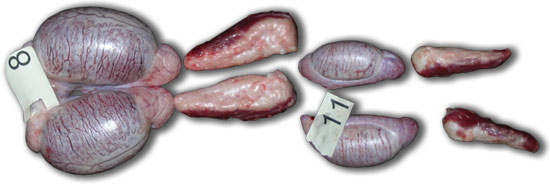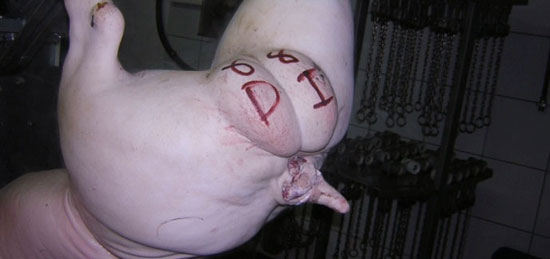With the objective of finding out how immunization against the gonadotropin-releasing factor (GnRF) affected meat and carcass quality, in the IRTA conducted experiments sacrificing 35 entire males (EM), 36 immunocastrated males (IM), 24 females (FE) and 23 surgically castrated males (CM). The experiment was carried out using Pietrain × (Landrace × Duroc) crossbred pigs. The animals were produced and controlled in the experimental unit (CAP) of IRTA-Monells. The slaughter was carried out in the experimental slaughterhouse of IRTA-Monells, stunning with C02 at 85% and following standard procedure. The objective was to compare the 4 sexes once slaughtered (average 180 days).
Live weight at slaughter, at the same age, was 123,77 kg for the IM and 111,64 kg for the EM, weights which were statistically different (p< 0.001). The results showed that the IM behaved like entire males until the second vaccine and then they gained an average of 12 kg.
As far as the effect of the vaccine on androstenone and escatol concentration, this study showed it to be 100% effective.
In figure 1 we can see the testes of IM and EM animals. An average reduction of 57% was seen in the testes, weighing 737g and 313 g for the EM and IM respectively. (table 1).

Figure 1. View of testes and the bulbo-urethral glands of an immunocastrated male (left) and an entire male (right).
It was observed that in the majority of the animals evaluated in the study, the differences between the testicles of the EM and IM were visible (figure 2).

| IM | EM | Sign. | |
| Testes weight (g) | 313.29 | 737.65 | *** |
| Testes length (mm) | 83.23 | 108.24 | *** |
| Bulbo-urethral gland weight (g) | 57.72 | 183.38 | *** |
| Bulbo-urethral gland length (mm) | 87.27 | 133.10 | *** |

On the other hand, when we analyzed the correlation between live weight, weight and length of testes and weight and length of the bulbo-urethral glands, it was noted that the relation between variables was much stronger in entire males compared to those vaccinated, except the correlation of testes length and live weight, which was similar (0.43 y 0.44) in both sexes (table 2).
In table 3 we can see that the males castrated at the same age (surgically or immunocastrated) as the entire males were significantly heavier. On the other hand the immunocastrated males were the ones that showed the worst yield, due in part to the presentation of the carcass, which was the same as an entire male as far as fat cuttings from the testes. The castrated group (CM and IM) presented a significantly higher percentage of subcutaneous fat and a lower % of estimated leanness. However, in the ham area (MLOIN), the immunocastrated animals were at the same level as the entire males, thereby showing that ham coming from an immunocastrated male will be leaner than that of a surgically castrated male.
| EM/IM | Testes Weight |
Testes Length |
Bulbo-urethral gland weight | Bulbo-urethral gland length |
| Weight T. | 1 | - | - | - |
| Length T. | 0.72/0.53 | 1 | - | - |
| Weight B.G. | 0.45/ns | ns/ns | 1 | - |
| Length B.G. | 0.38/ns | ns/ns | 0.69/0.51 | 1 |
| Live weight (kg) | 0.38/ns | 0,44/0,43 | ns/ns | ns/ns |
| CM |
IM |
EM |
FE |
Sig. | |
| Live weight (kg) | 120.96a |
123.77a |
111.64b |
107.92b |
*** |
| Carcass weight (kg) | 97.68a |
97.09a |
89.08b |
87.41b |
*** |
| Yield (%) | 80.76a |
78.65c |
79.81b |
81.02a |
*** |
| MLOIN | 20.10 a |
15.75b |
10.02c |
14.17b |
*** |
| LR3/4 FOM (mm) | 20.47a |
19.68a |
15.21b |
16.06b |
*** |
| % Lean FOM | 53.05b |
53.66b |
57.10a |
56.89a |
*** |
LR3/4 FOM: Fat measurement taken with Fat-o-Meat’er.***: P<0.001
With respect to meat quality (table 4), no significant differences were observed (p>0.05) between sexes, except among the intramuscular fat (INFASM), in which castrated males had significantly higher percentages than entire males, while the immunocastrated males were in between.
| CM |
IM |
EM |
FE |
Sig. | |
| pH45LT | 6,29 |
6,27 |
6,26 |
6,25 |
NS |
| pH24LT | 5,49 |
5,47 |
5,49 |
5,47 |
NS |
| Japonese color scale | 2.8 |
2.8 |
2.9 |
2.9 |
NS |
| INFA SM (%) | 2,47a |
2,07ab |
1,84b |
1,72b |
*** |
INFASM: % intramuscular fat. LT: Longissimus thoracis; SM: Semimembranosus.
***:P<0.001
Conclusions
Immunocastration could be a good alternative to surgical castration for the elimination of boar taint.
Immunocastration produces carcases that are similar to those of surgically castrated males in the dorsal zone, while in the ham area they are more similar to the females. Immunocastration has no effect on the quality of the meat except in the intramuscular fat which tends to increase.




